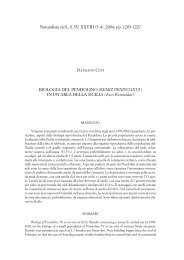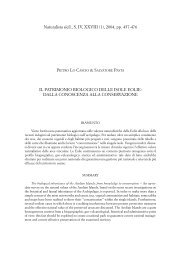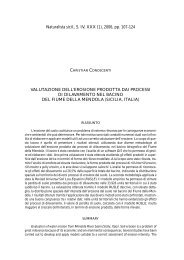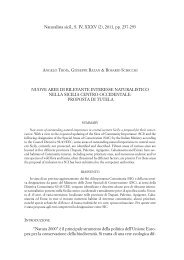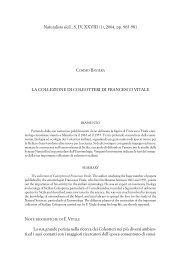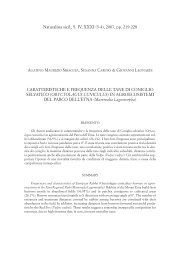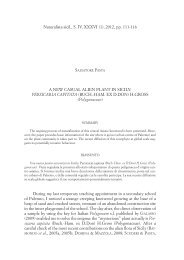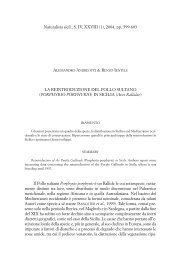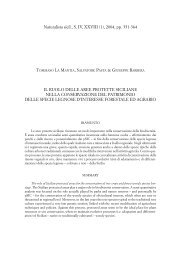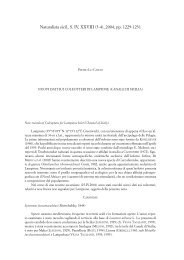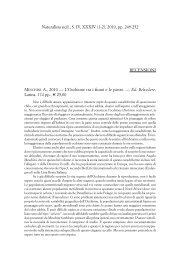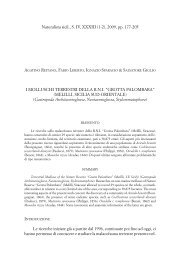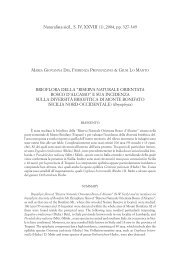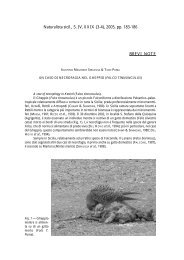2007,pp - Società Siciliana di Scienze Naturali
2007,pp - Società Siciliana di Scienze Naturali
2007,pp - Società Siciliana di Scienze Naturali
You also want an ePaper? Increase the reach of your titles
YUMPU automatically turns print PDFs into web optimized ePapers that Google loves.
276 M. SKUHRAVÁ, V. SKUHRAVY´ & B. MASSA<br />
obtained from its galls some parasitoids in May-July; RIZZO & MASSA (1998)<br />
found galls on many localities of Sicily, where it is widespread and common<br />
from spring to autumn. Distribution: Euro-Siberian.<br />
Dasineura acrophila (Winnertz, 1853)<br />
Larvae cause leaflet galls on Fraxinus excelsior L. and F. angustifolia L.<br />
(Oleaceae). Only one generation develops a year. Fully grown larvae leave the<br />
galls, fall to the ground where they hibernate. Adults emerge in the spring. Occurrence:<br />
Sicily, Lo Zucco (Palermo), 11.4.2000, galls containing 4 larvae, leg. R. Lo<br />
Duca. New record for Sicily. Distribution: European up to North Africa.<br />
Dasineura affinis (Kieffer, 1886)<br />
Larvae cause galls on leaves of various Viola species (Violaceae). Leaf margins<br />
are thickened and curled upwards (Pl. V, Figs. 23 and 24). Several overla<strong>pp</strong>ing<br />
generations develop in one year. Females usually lay their eggs on the<br />
youngest leaves. Fully grown larvae spin cocoons and pupation takes place in<br />
the galls. D. affinis cause galls on wild and cultivated violets. RAGUSA (1970c)<br />
stu<strong>di</strong>ed the biology of this species in detail on plants of V. hirta var. odorata near<br />
Palermo, advising chemical control to reduce populations of this pest in Sicily.<br />
Distribution: European, with large <strong>di</strong>stribution area inclu<strong>di</strong>ng North Africa<br />
and Kazakhstan.<br />
Dasineura crataegi (Winnertz, 1853)<br />
Larvae live gregariously among deformed leaves in terminal rosette galls<br />
on Crataegus laevigata (Poiret) DC (= C. oxyacantha L.) (Rosaceae) (Pl. VI,<br />
Fig. 36). Some larvae pupate in galls, some larvae leave galls and pupate in the<br />
soil. Two generations a year. Occurrence: DE STEFANI (1917) recorded this<br />
species on Crataegus azarolus in Sicily without giving a locality. Distribution:<br />
European (large area), it also occurs in Turkey (SKUHRAVÁ et al., 2005).<br />
Dasineura ericaescopariae (Dufour, 1837)<br />
Larvae cause large galls at tips of shoots of Erica scoparia L. and E.<br />
arborea L. (Ericaceae) (Pl. IV, Fig. 21). Many larvae live together inside one<br />
gall. Only one generation develops a year. Larvae overwinter in the galls.<br />
Adults emerge in spring. Occurrence: coastal areas of Palermo, Cefalù,<br />
Caronie, S. Marco d’Alunzio, S. Agata Militello, Messina (DE STEFANI, 1902,<br />
1906c, DE STEFANI jr, 1942). Distribution: Me<strong>di</strong>terranean.<br />
Dasineura galiicola (F. Löw, 1880)<br />
Larvae cause spongious galls at the vegetative tips of various species of



